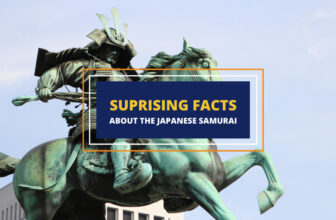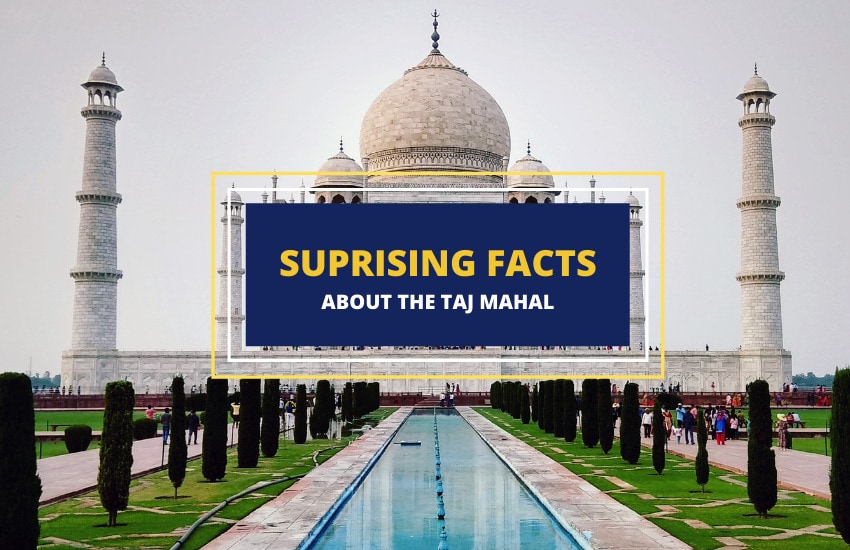
Table of Contents
The Taj Mahal is a stunning palace on the banks of the river Yamuna in the Indian city of Agra, where it has been standing since the 17th century.
One of the most recognizable buildings in the world, the Taj Mahal has become an important tourist site as millions of people flock to see the magnificent architecture of this beautiful palace. For centuries, the Taj Mahal has been considered one of the most important architectural masterpieces in India.
Here are twenty interesting facts about the Taj Mahal and what makes it capture the imaginations of millions of people around the world.
1- The construction of the Taj Mahal revolves around a love story.
Shah Jahan commissioned the building of the Taj Mahal. He wanted the building to be erected in the memory of his beloved wife Mumtaz Mahal who had died the same year after giving birth to the Shah’s 14th child.
Although Shah Jahan had other wives throughout his life, he was very close to Mumtaz Mahal as she was his first wife. Their marriage lasted around 19 years and was deeper and meaningful than any of his other relationships during his lifetime.
The Taj Mahal was constructed between 1632 and 1653. While the main part of the building was finished in 1648 after 16 years, construction continued for the next five years as the final touches were completed.
Because of this association, the Taj Mahal has become a symbol of everlasting love and loyalty.
2- The name Taj Mahal has Persian origins.
Taj Mahal derives its name from the Persian language, where Taj means crown and Mahal means palace. This indicates its position as the pinnacle of architecture and beauty. But interestingly, the Shah’s wife’s name was Mumtaz Mahal – adding a second layer of meaning to the name of the building.
3- Taj Mahal has a huge garden complex.
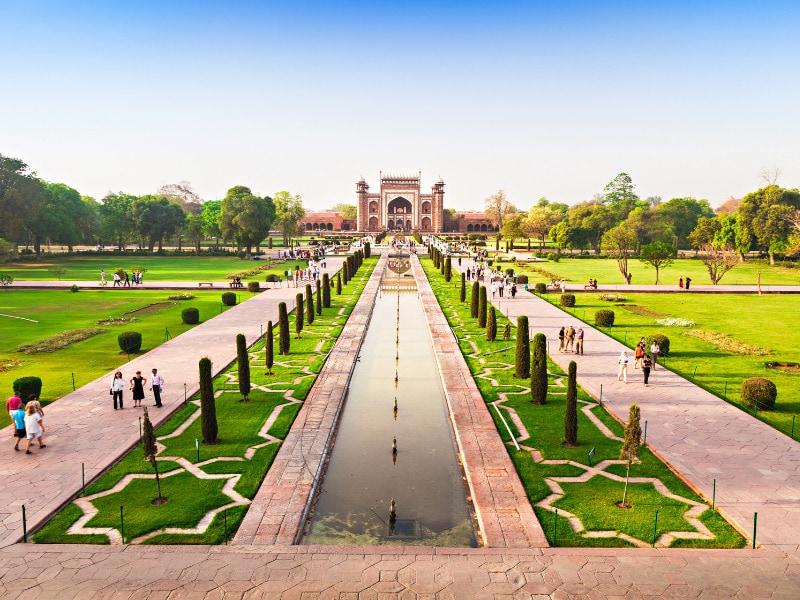
The garden complex around the Taj Mahal consists of a 980 feet Mughal Garden that separates the land into several different flower beds and pathways. The gardens were inspired by Persian architecture and garden styles that resonate in many landscaping details around the Taj Mahal. The Taj Mahal is also famous for its beautiful reflecting pool that shows a stunning reverse image of the structure on its surface.
However, the gardens and grounds of the Taj Mahal that we see today are a shadow of how they used to look. Prior to the British in India, the gardens had been filled with fruit trees and roses. However, the British wanted a more formal look, less focused on colors and flowers, and so the gardens were changed to reflect the British style.
4- The white marble of the Taj Mahal reflects light.
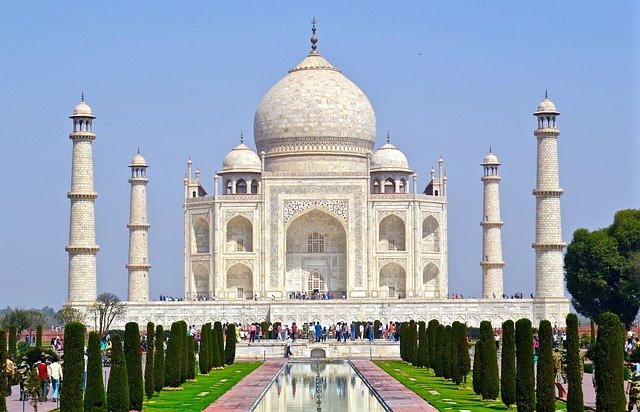
In a rather romantic and poetic fashion, the Taj Mahal reflects the mood of the day by reflecting sunlight on its splendid façade. This phenomenon occurs several times per day.
Although it has not been confirmed whether this was the original intention of the builders, some more poetic interpretations suggest that this change of light is not without purpose and that it reflects the feelings of the late Shah after the death of his wife.
The change of light reflects a switch from bright and warm tones and moods of the morning and day into a melancholic darker blue and purple hues of the night.
5- 20,000 people were hired to build the Taj Mahal.
More than 20,000 people worked on the construction of the Taj Mahal which took more than 20 years to complete. The Taj Mahal and its construction was a feat of engineering that could have only been accomplished by the most skilled artisans and experts. Shah Jahan brought in people from all corners of India and many other places like Syria, Turkey, Central Asia, and Iran.
The workers and artisans who were involved in the construction of the Taj Mahal were handsomely paid for their work. A famous urban legend states that Shah Jahan cut off the hands of the entire workforce (around 40,000 hands) so that nobody would ever build a structure as beautiful as the Taj Mahal ever again. This, however, is not true.
6- There are precious stones and calligraphy in the walls.
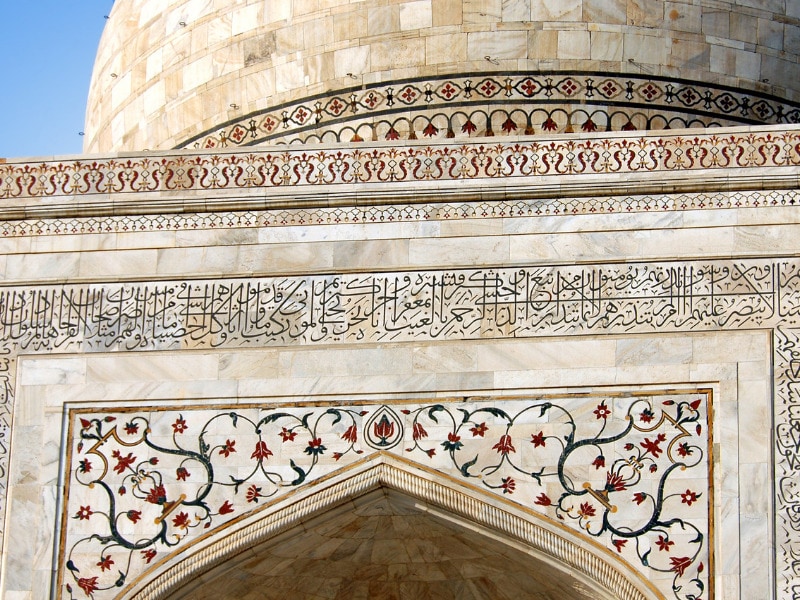
The walls of the Taj Mahal are highly decorative and ornamental. These walls are adorned with precious and semi-precious stones that can be found inlaid in the white marble and red sandstone of the edifice. There are up to 28 different types of stones found in the marble, including sapphire from Sri Lanka, turquoise from Tibet, and lapis Lazuli from Afghanistan.
Beautiful Arabic calligraphy and verses from Koran can be seen everywhere on this structure, inlaid with floral patterns and semi-precious gems.
These ornaments are truly considered masterworks on their own, resembling the Florentine traditions and techniques where artists would inlay jade, turquoise, and sapphire in the shimmering white marble.
Sadly, the British Army took many of these decorations from the Taj Mahal, and they were never reclaimed. This indicates that the Taj Mahal was even more beautiful than it is today, and its original ornaments probably left many visitors speechless.
7- The tomb of Mumtaz Mahal is not decorated.
Although the entire complex is highly decorated with precious stones and shimmering white marble, contrasted by beautiful gardens and red sandstone buildings, the tomb of Mumtaz Mahal does not have any ornaments.
There is a specific reason behind this, and it lays in the fact that as per Muslim burial practices, decorating graves and tombstones with ornaments is considered unnecessary, lavish, and verging on vanity.
Therefore, the tomb of Mumtaz Mahal is a humble memorial of Shah’s late wife without any extravagant ornamentation on the grave itself.
8- The Taj Mahal is not as symmetrical as you might think.
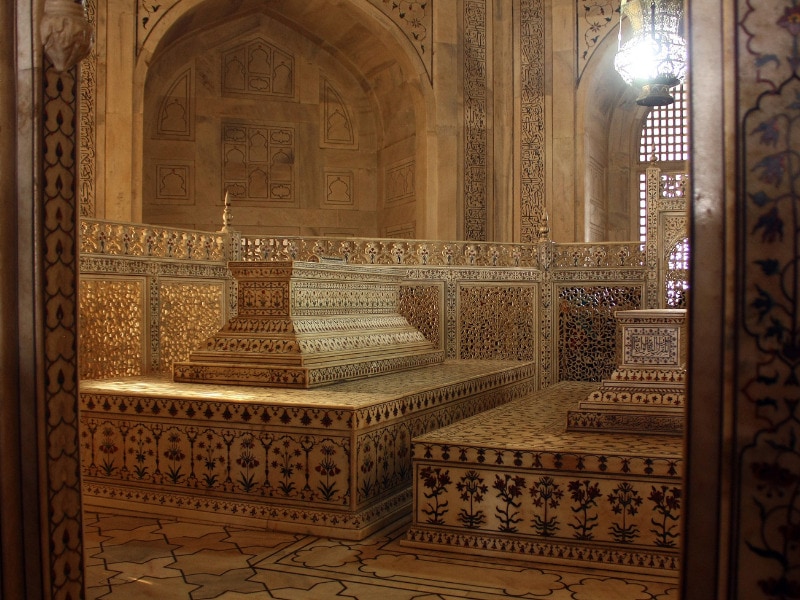
Taj Mahal is beloved for its picture-perfect imagery that looks perfectly symmetrical to the point that it seems like something out of a dream.
This symmetry was purposeful, and the artisans took great care to ensure that the entire complex resonates in perfect balance and harmony.
Despite being seemingly symmetrical, there is one thing that stands out in comparison to the entire complex and it somehow disturbs this carefully assembled equilibrium. This is the casket of Shah Jahan himself.
After the death of Shah Jahan in 1666, the tomb was placed in the mausoleum breaking the perfect symmetry of the complex.
9- The minarets are tilted on purpose.
Look closely enough and you might spot that the four 130-feet tall, towering minarets that stand around the main complex are slightly tilted. You might wonder how these minarets are tilted given that more than 20,000 craftsmen and artists worked on ensuring the perfection of this place. This tilt was done with a very specific purpose in mind.
The Taj Mahal was built so that in the event of its collapse, the tomb of Mumtaz Mahal would remain protected and undamaged. Therefore, the minarets are slightly askew so that they would not fall on the crypt of Mumtaz Mahal ensuring that her grave is permanently protected.
10- Shah Jahan was banned from entering the Taj Mahal.
Shah Jahan’s sons from his marriage with Mumtaz began fighting over succession nine years before the Shah died. They noticed that their father was ill, and each wanted to secure the throne for themselves. One of the two sons emerged victorious, and it was the son that Shah Jahan did not side with.
Once it was clear that Shah Jahan had made an unwise decision in siding with the son that lost this game of thrones, it was clearly too late, and the victorious son Aurangzeb stopped his father from ever regaining power in Agra.
One of the decisions that his son made was that Shah Jahan will not be allowed to enter the premises of the Taj Mahal.
This meant that the only way Shah Jahan could observe his monumental work was through the balconies of his nearby residence. In a rather tragic turn of events, the Shah Jahan was never able to visit the Taj Mahal and see his beloved Mumtaz’s grave one final time before his death.
11- Taj Mahal is a place of worship.
Many think the Taj Mahal is merely a tourist destination that serves millions of tourists every year, however the complex of Taj Mahal is equipped with a mosque that is still functional and used as a place of worship.
The beautiful mosque is built out of red sandstone and chose intricate ornamental decorations and is perfectly symmetrical to the holy site of Mecca. Since the mosque serves as an integral part of the complex, the entire place is closed to visitors on Fridays for prayer purposes.
12- Taj Mahal was camouflaged during wars.
Out of fear that it might be bombarded, the Taj Mahal was hidden from the view of pilots that might bomb it during all major wars.
During the Second World War, the British covered the entire building in bamboo. This made it look like a mass of bamboo rather than the architectural marvel that it is, and saved the building from any attempts at bombing by British enemies.
The gleaming white marble of the Taj Mahal does not make it a very hard building to spot so hiding such a monumental edifice was a challenge.
While we do not know whether there were ever any real intentions to bomb the Taj Mahal, India continued to use this camouflaging strategy in wars against Pakistan in 1965 and 1971.
Perhaps thanks to this strategy, the Taj Mahal is proudly standing today with its gleaming white marble.
13- Shah Jahan’s family was buried around the mausoleum.
Even though we associate the Taj Mahal with the beautiful love story between Shah Jahan and his wife Mumtaz Mahal, the complex also houses mausoleums to other family members of the Shah.
The Shah’s other wives and beloved servants are buried around the mausoleum complex, and this was done to show respect for some of the most important people in his life.
14- Mumtaz Mahal and Shah Jahan are not actually buried inside of the mausoleums
There is a very specific reason why upon entering the mausoleums you will not be able to see the graves of Mumtaz Mahal and Shah Jahan.
You will see two cenotaphs commemorating the pier adorned with marble and calligraphic inscriptions however the actual graves of Shah Jahan and Mumtaz Mahal are in a chamber below the structure.
This is because Muslim traditions forbid graves from being excessively decorated.
15- Elephants helped in the construction of the Taj Mahal.
Alongside 20,000 artisans working on the Taj Mahal thousands of elephants were equipped to help with carrying the heavy load and transport the building materials. Over two decades more than 1000 elephants were used in accomplishing this feat of engineering. Without the help of elephants, the construction would have lasted much longer, and the plans would probably have needed to be modified.
16- There are concerns for the integrity of the structure.
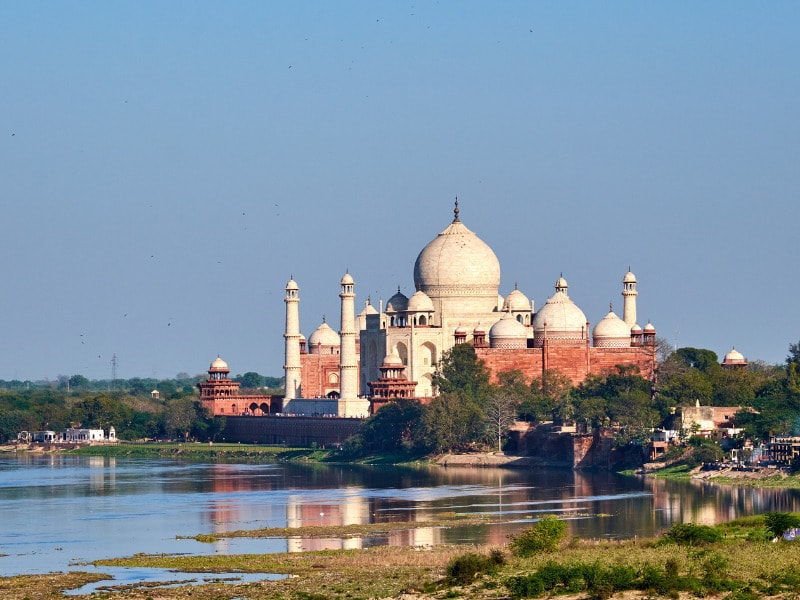
The structure of the Taj Mahal was thought to be perfectly stable for centuries. However, erosion from the nearby Yamuna River could pose danger to the structural integrity of the Taj Mahal. Such environmental conditions could pose ongoing threats to the structure.
There were two occasions of severe storms in 2018 and 2020 that also caused some damage to the Taj Mahal, raising fears among the archaeologists and conservators.
17- The gleaming white facade is strictly protected.
The gleaming white façade of the Taj Mahal is strictly maintained, and no vehicles are allowed to come more than 500 meters within the buildings.
These measures were introduced because the conservators figured out that the pollution from vehicles settles on the surface of the white marble and causes the darkening of the exterior of the building. The yellowing of the white marble comes from the carbon content that is released by these gases.
18- Taj Mahal is visited by around 7 million people every year.
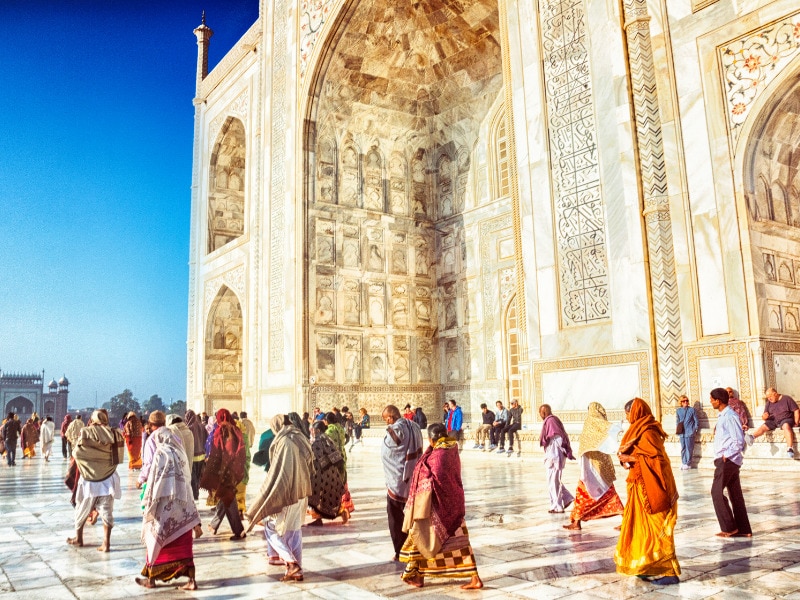
The Taj Mahal is probably India’s greatest tourist landmark and close to 7 million people visit it every year. This means that tourist authorities must keep a close eye on the number of tourists allowed, if they are to preserve the integrity of the structure and maintain the sustainability of the tourism in the area.
There is a cap of around 40,000 visitors allowed to visit the complex every day to protect the buildings from further damage. As the numbers of tourist continues to increase, further measures may be taken to protect the building.
UNESCO, closely with the Indian government, monitors and documents the numbers of tourists that come every year. Local authorities have decided to start fining everyone who stays longer than three hours at the site to protect the grounds.
19- Taj Mahal is a UNESCO World Heritage site.
Taj Mahal has been a designated UNESCO World Heritage site since 1983 and is labeled as one of the world’s seven wonders.
20- A black Taj Mahal may have been in the works.
Although unconfirmed, some French explorers like Jean Baptiste Tavernier gave accounts of meeting Shah Jahan and learning that he had original plans to build another Taj Mahal that would serve as a burial tomb for himself.
According to Tavernier’s account, the Shah Jahan tomb was supposed to be black so that it would contrast whith his wife’s white marble mausoleum.
Wrapping Up
The Taj Mahal is truly one of the greatest architectural wonders of the world and has been proudly standing on the banks of the river Yamuna for centuries.
The Taj Mahal is not only an architectural masterpiece, but it is also a reminder of the power of love and affection that lasts for eternity. However, the red sandstone construction may not last for eternity, as with many other wonders of the world, tourism, and accelerated urbanization in the areas around the site cause excessive pollution and damage.
Only time will tell whether the Taj Mahal will be able to keep up with the eternal love of its famous residents.





